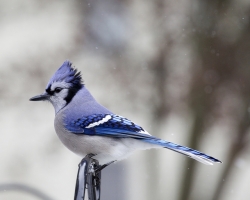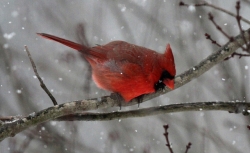Though penguins are the most well known, many different kinds of birds call the Arctic and Antarctic home for at least part of the year. Many seabirds birth and raise their young in the very cold places in the far north and south during the summer months. Yet other different kinds of birds remain in these cold places through all of the year. These birds use different
behaviors, or things that living things choose or decide to do, to stay alive.

Blue jays are among several species of bird that do not migrate during the winter.
Dawn Huczek on Flickr.com
If you live in a place with cold, snowy winters, you know that January means putting on the coats, scarves, and gloves, and perhaps drinking a hot drink. But how do birds that spend their winters in cold places stay warm? Packed into those birds are physical parts and actions that make it easier for them to live in certain places to keep them cared for through all of the year. They have changed and learned over time what they can do to stay warm.
Behavioral adaptations are actions that living things have learned to do over a long period of time that help them to stay alive and make babies.
First, birds' feathers give a lot of insulation, or padding to keep warm.
Insulation is anything that is meant to stop heat from moving from one place to another. These birds work to keep heat from leaving their bodies. You might have seen that birds "fluff up." They fluff their feathers to trap air between their feathers and bodies. The result is a layer of insulation, like a down sleeping bag. Also, when they sleep or rest, the birds tuck their bills under their wing feathers in order to breathe in this warmer air.

Does this cardinal look chubby? He's actually fluffing his feathers to trap air and stay warm!
fishhawk on Flickr.com
You may also notice many birds coming to eat the bird food you put out when it is cold and snowy. Like mammals, birds are warm-blooded and need to burn energy to keep warm. In the winter, they must eat to keep up their heart rate and be able to shake to keep their body temperature. As in people, the shaking keeps birds warm.
While a few birds have feathers on their feet to help keep warm, many birds have naked feet. Some birds stay warm by tucking one foot up under its feathers, standing on one leg. In other birds, the way their blood flows in their feet helps keep the heat loss to the smallest amount possible.
Concurrent blood exchange is when the warm blood that goes out to the feet flows next to the blood coming back into the body from the feet and warms it up to come back into the body. This way the feet can stay cold, but the body can stay warm. If you've ever seen a duck swimming along an iced pond, you may have thought about how its feet don't freeze. Those feet are not thick enough to have a protecting, or warming, layer of fat, nor are they covered in feathers. The blood moves close to their skin, cooling quickly in the freezing water. These birds must make equal the need to protect their body heat with the need to give their legs and feet enough air, nutrients, and warmth.

If these ducks were to hop into the frigid water, concurrent blood exchange would keep their feet from freezing.
liz west on Flickr.com
Birds also might change behaviors in the cold. Besides eating more, some birds come close together to keep warm. Birds may hide in a snow, dig a hole for a safe place to keep warm.
Finally, while many people think migration, or moving from cold to warm weather, is a way for birds to "escape the cold," often the migration takes place to make sure there is enough food to eat, rather than to just stay warm.

Birds who do migrate often do so because food is scarce in the winter and not just because of the cold.
nick goodrum at Flickr.com